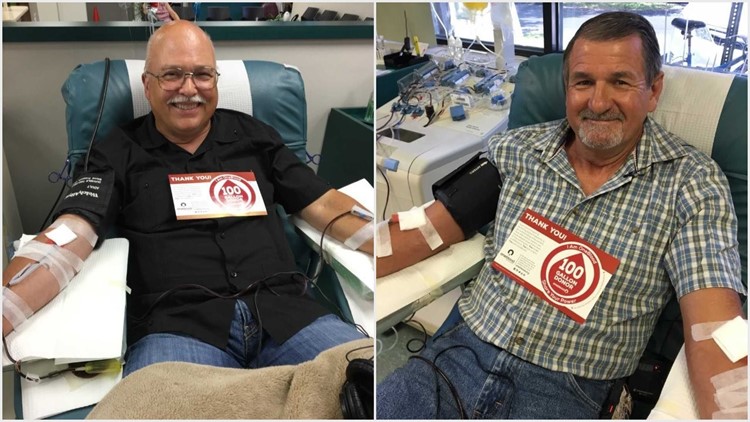When a coworker needed blood back in 1986, Fred Lucardie rolled up his sleeve and became a blood donor. He continued to give whole blood until the early 1990’s when his wife began her battle against cancer and needed regular platelet transfusions. Learning about the need for platelet donors and the fact that this was the best gift for him to give as a Type A positive donor, he started donating in this special way. He set a goal to reach 100 gallons. On Thursday, he achieved it.
“Maybe I’ll put another 25 or 30 gallons on it for my goal,” he said.
Tampa resident Marty Caruthers first donated whole blood in the mid 1990’s when a woman in his church needed blood for surgery. The blood center staff told him what great veins he had, explained to him of the great need for platelet donors and the automated donation process to collect them. Then they showed him pictures of cancer kids who needed platelets, due to the effects of chemotherapy and he signed up. He hit the 100-gallon mark on Thursday, too.


“I said when I hit 100 gallons I’m going to party,” he said with a chuckle.
Their donations helped save countless lives.
Lives like Kathy Jones.
“For the better part of a year, I relied on platelet donation and on whole blood donation. Just dependent, like three times per week,” she said. “(Blood donors) just do it because to them it’s the right thing to do, and it is.”
Kathy diagnosed with Acute Aplastic Anemia 14 years ago. Transfusions helped her survived. She’s now a grandmother, thanks to generosity of donors like Lucardie and Caruthers.
“Donors give second chances to so many people, and that’s what touches our hearts,” said OneBlood’s Dan Eberts. “They are a minority of the minority who give blood for the majority.”
Lucardie and Caruthers reached 100 gallons on World Blood Donor Day, which is dedicated to “thanking and celebrating voluntary, non-remunerated blood donors.” It occurs on June 14, the birthday of Karl Landsteiner, the creator of the ABO blood group system, for which he won the Nobel Prize. The first day was held in 2005.
Transfusion of blood and blood products helps save millions of lives every year. It can help patients suffering from life-threatening conditions live longer and with higher quality of life, and supports complex medical and surgical procedures. It also has an essential, life-saving role in maternal and child care and during man-made and natural disasters.
However, in many countries, demand exceeds supply, and blood services face the challenge of making sufficient blood available, while also ensuring its quality and safety. An adequate supply can only be assured through regular donations by voluntary, unpaid blood donors. The World Health Organization’s goal is for all countries to obtain all their blood supplies from voluntary, unpaid donors by 2020.
Today, only 62 countries get close to 100 percent of their national blood supplies from voluntary unpaid blood donations, with 40 countries still dependent on family donors and even paid donors.
Generally, healthy people age 16 or older who weigh at least 110 pounds can donate blood. All donors receive a wellness checkup including blood pressure, temperature, iron count, pulse and cholesterol screening, plus a surprise gift.
To learn more about the importance of blood donation and how donors can target the power of their blood type, visit oneblood.org or call 1.888.9DONATE, 1.888.936.6283.


